1. Read instructions-All the safety and operating instructions should be read before the appliance is operated.
2. Retain instructions-The safety and operating instructions should be retained for future reference.
3. Warnings-All warnings and cautions on the appliance and in the operating instructions should be adhered to.
4. Follow instructions-All operating and use instructions should be followed.
5. Water and Moisture-The appliance should not be used near water, e.g. near a bathtub, washbowl, kitchen sink,
laundry tub, in a wet basement, or near a swimming pool or the like.
6. Wall or Ceiling Mounting-The appliance should not be mounted to a wall or ceiling.
7. Ventilation-The appliance should be situated in the location or position which does not interfere with its proper
ventilation. For example, the appliance should not be situated on a bed, sofa, rug or similar surface that may block
the ventilation openings, or placed in a built-in installation, such as a bookcase or cabinet, that may impede the
flow of air through the ventilation openings.
8. Heat-The appliance should be situated away from heat sources such as radiators, heat registers, stoves, or other
appliances (including amplifiers) that produce heat.
9. Power Sources-The product should be operated only with the type of power supply indicated on the marking
label. If you are not sure of the type of power supply to your home, consult your product dealer or local power
company. For products intended to operate from battery power, or other sources, refer to the operation
instructions.
10. Grounding Polarization-This product may be equipped with a polarized alternating current line plug (a plug having
one blade wider than the other). This plug will fit into the power outlet only one way this is a safety feature. If you
are unable to insert the plug fully into the outlet, try reversing the plug. If the plug should still fail to fit, contact your
electrician to replace your obsolete outlet. Do not defeat the safety purpose of the polarized plug.
11. Power-Cord Protection-Power supply cords should be routed so that they are not likely to be walked on or
pinched by items placed upon or against them, paying particular attention to cords at plugs, convenience
receptacles, and the point where they exit from the appliance.
12. Cleaning-The appliance should be cleaned only as recommended by the manufacturer.
13. Not in use periods-The power cord of the appliance should be unplugged from the outlet when left or not use for a
long period of time.
14. Object and Liquid Entry-Care should be taken so that objects do not fall and liquids are not spilled into the
product case through product openings.
15. Damage for repairing-Unplug this product from the wall outlet and take it to qualified service personnel under the
following conditions.
a) When the power-supply cord or plug is damaged.
b) If liquid has been spilled into, or objects have fallen into the product.
c) If the product has been exposed to rain or water.
d) If the product does not operate when used according to the operating instructions.
Adjust only those controls that are covered by the operating instructions as an improper adjustment of other
controls may interfere with the productÕs normal operation.
e) If the product has been dropped or damaged in any way.
f) When the product exhibits a distinct change in performance-this indicates a need for service.
16. Servicing-The user should not attempt to service the product beyond that described in the operating instruction.
All servicing should be referred to qualified service personnel.
17. Power Lines-An outside antenna system should not be located in the vicinity of overhead power lines, or other
electric light or power circuits, or where it can fall into such power lines or circuits. When installing an outside
antenna system, extreme care should be taken to keep from touching power lines or circuits as contact with them
might be fatal.
18. If an outside antenna is connected to the receiver, be sure the antenna system is grounded so as to provide some
protection against voltage surges and built up static. Section 810 of the National Electrical Code ANSI/NEFA 70
provides information with respect to proper grounding of the mast and supporting structure, grounding
conductress, location of antenna-discharge unit, size of grounding electrodes, and requirements for the grounding
electrode (see figure).
19. Cleaning-Unplug this product from the wall outlet before cleaning. Do not use liquid cleaners or aerosol cleaners.
Use a damp cloth for cleaning.
20. Lightning-For added protection for this product during a lightning storm, or when it is left unattended and unused
for long period of time, unplug it from the wall outlet and disconnect the antenna or cable system. This will prevent
damage to the product due to lightning and power-line surges.
21. Safety Check-Upon completion of any service or repairs to this product, ask the service technician to perform
safety checks to determine that the product is in proper operation condition.
22. Overloading-Do not overload wall outlets, extension cords, or integral convenience receptacles as this can result
in a risk of fire or electric shock.
ENG-2

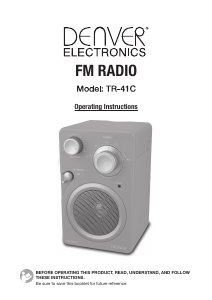


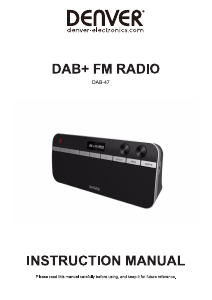

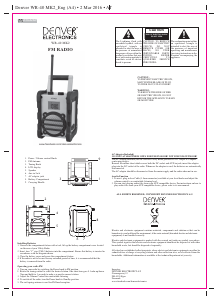
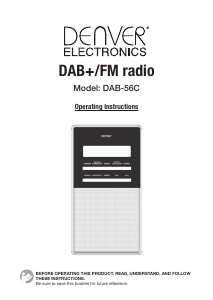

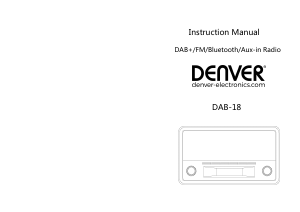

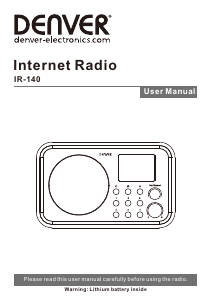
Join the conversation about this product
Here you can share what you think about the Denver TR-41C Radio. If you have a question, first carefully read the manual. Requesting a manual can be done by using our contact form.